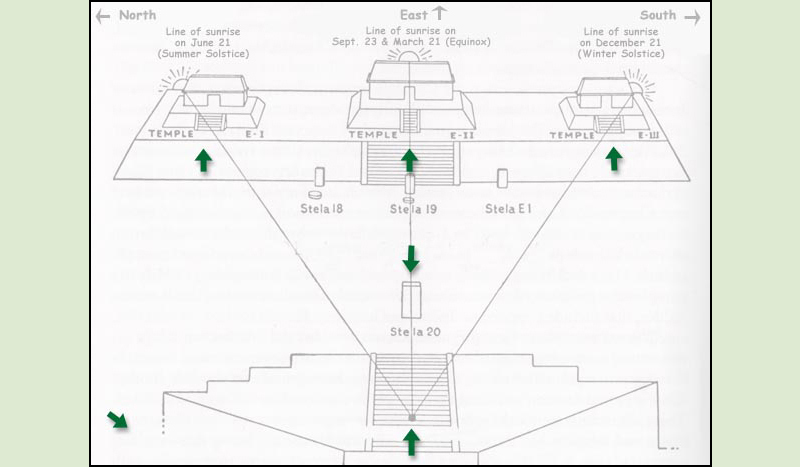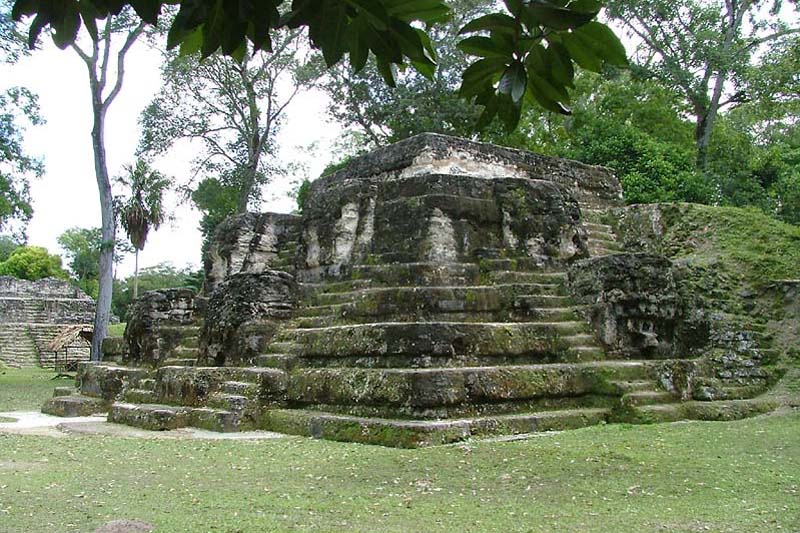

Archecture: Uaxactun is notable for an archaeological complex known as an "E Group" which was first identified here and which served as a kind of astronomical observatory for marking the equinox and solstice paths of the sun.
Such complexes take their name from Structure E-VII-sub, which is an early classic structure dating from approximately 200 A.D. E-Groups were quite common in the central lowlands during the early classic: other examples are found at Calakmul, Tikal, and elsewhere.
Pottery: Photos from the El Chiclero Museum at Uaxactun. These pots were collected by the Chicleros from a large number of sites in the area. Both Nikolai Grube and Sofia Paredes have documented the collection and their reports are available at the museum.
"Uaxactun is located some 40 km north of Tikal, and although it is substantially smaller than Tikal, its span of occupation seems to have been about the same, with origins in the Middle Preclassic and abandonment by the Early Postclassic.
Research conducted at Uaxactun from 1926 to 1937 by the Carnegie Institution established the basic cultural chronology for the central lowlands and was used as the starting point for almost all other chronological sequences in the region. It was founded on Uaxactun's available calendrical inscriptions, pottery sequence, and architectural development.
As a case in point, the chronology of pottery forms and types at Tikal, owing to their similarities to those at Uaxactun, is founded on the work done by the original Carnegie researchers here."
Robert Sharer, The Ancient Maya, p. 181

Drawing adopted from Robert Sharer, The Ancient Maya, p. 182
Click on GREEN ARROWS in map to view photos of specific buildings, or continue scrolling
Our annotated Uaxactun reading list.
NEW! Subscribe to our free newsletter, MayaRuins Insights
"The ancient Mayas were aware of the annual transit of the sun along the horizon and used it ritually, even though there was not a method for recording it in the complex Maya calendar. Modern Maya groups are still acutely aware of the solar cycle as defined by the passage of the sun from north to south on the horizon...
Mounting evidence from epigraphers, ethnographers, and astronomers indicates that the Maya conceived of the directions not as east, west, north and south, but as the four solstitial sunrise and sunset points, plus zenith and nadir."
Carolyn E. Tate, Yaxchilan: The Design of a Maya Ceremonial City, p 112

This is the north side of E-VII-sub, which was a radial pyramid with faces oriented to all four cardinal directions.

The excavations in Group E at Uaxactun revealed the first known Maya architectural assemblage aligned so as to function as an astronomical observatory.
In the foreground is the pyramid, E-VII-sub, which faces three smaller sighting temples to the east. The central sighting temple is visible in the background to the left.

"On the west side of a court at Uaxactun, facing due east, was a pyramid. On the opposite side, on a terrace, were three temples with façades running north and south, and arranged so as to establish lines of sight when observed from the stairway of the pyramid on the west side.
From this observation point, the sun, on its way north, rose directly behind the middle temple (Str. E-II) on March 21, the vernal equinox; behind the northernmost front corner of the north temple (Str. E-I, left) on June 21, the summer solstice; behind the middle temple again on its way back south on September 23, the autumnal equinox; and behind the southernmost front corner of the south temple (Str. E-III, right) on December 21, the winter solstice.
This assemblage of buildings thus marked the longest and shortest days of the year, as well as the two intermediate positions, when day and night are of equal length."
Robert Sharer, The Ancient Maya, p. 181

"The most unusual feature of Chicanel culture, however, is the high elaboration of architecture, above all in the latter part of the Late Preclassic, from 100 B.C. to A.D. 250. It must be remembered that the Petén-Yucatán shelf is blessed with an inexhaustible supply of easily cut limestone, and with abundant flint for tools with which to work it.
Moreover, the Maya of the lowlands had discovered as far back as Mamón times that if limestone fragments were burnt, and the resulting powder mixed with water, a white plaster of great durability was obtained. And finally, they quickly realized the structural value of a concrete-like fill made from limestone rubble and marl.
With these resources at hand, the Maya temple architect was able to create some elaborate constructions at a very early date. At the great Petén sites of Uaxactún, Tikal, and El Mirador, deep excavations have shown that major pyramids, platforms, and courts were already taking shape by late Chicanel times.
There is general agreement, for instance, that the E-VII-sub pyramid at Uaxactún was built late in the Chicanel phase; beautifully preserved by the overlay of later structures, this truncated temple platform is faced by brilliantly white plaster [which unfortunately has become moss-covered and blackened since its uncovering] and rises in several tiers each having the apron moldings which are so distinctive a feature of Maya architecture in the lowlands.
On all four sides are centrally placed, inset stairways flanked by great monster masks which apparently represent the Jaguar God of the Underworld (the night sun), as well as sky-serpents. Postholes sunk into the floor show that the superstructure was a building of pole and thatch."
Michael D. Coe, The Maya, p. 61-2

Excavation of the badly ruined Str. E-VII revealed a well-preserved earlier platform underneath, thereafter dubbed E-VII-sub.
This substructure dates from the Late Preclassic era, and at the time of its discovery it was the earliest building known from the Maya lowlands.
The terraced surfaces of E-VII-sub were completely covered with lime-based plaster, as were its four stairways and sixteen side masks, two at each side of each stairway.
These masks seem to depict cosmological themes similar to those found on Str. 5C-2nd at Cerros, in Belize, a center that reached its apogee in the Late Preclassic...Since E-VII-sub's discovery, several buildings of the same age have been excavated, including the larger Lost World Pyramid at Tikal and Str. 5C-2nd at Cerros.
Robert Sharer, The Ancient Maya, p. 181-2

For an observer standing on the viewing platform of Pyramid E-VII across the courtyard, the sun rose directly behind Temple E-II on both the vernal (March 21) and autumnal equinox (September 23).


Seen from the pyramid across the courtyard, the sun rose directly behid Temple E-I on June 21, the summer solstice.

Viewed from Pyramid E-VII across the courtyard, the sun rose directly behind Temple E-III on December 21, the winter solstice. >